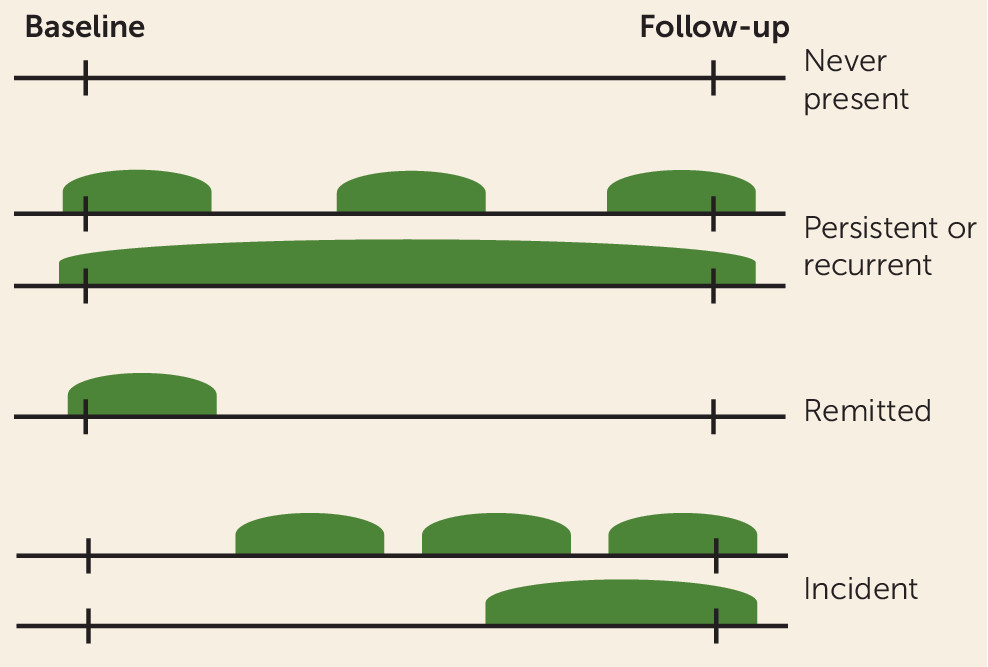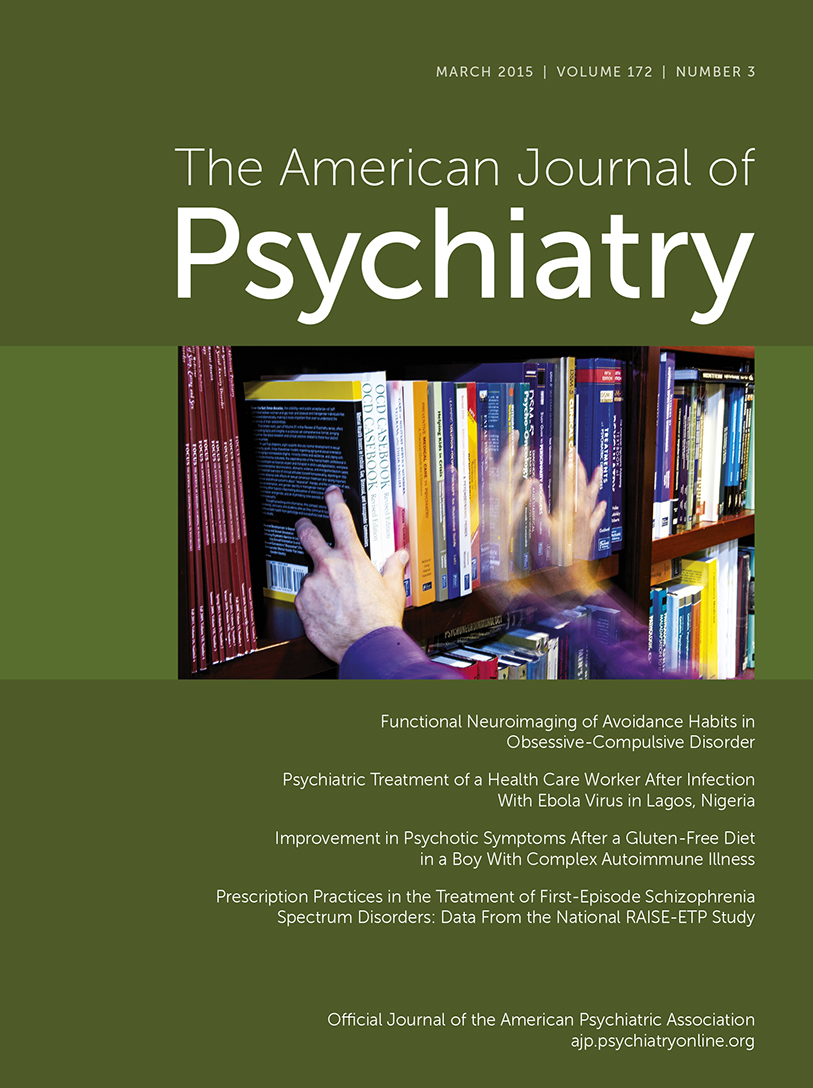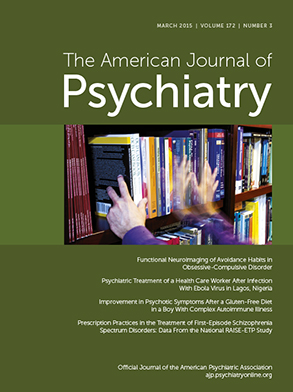Outcomes of Nontransitioned Cases in a Sample at Ultra-High Risk for Psychosis
Abstract
Objective:
Method:
Results:
Conclusions:
Method
Participants and Procedure

Measures
Follow-up assessment.
Baseline assessment.
Statistical Analyses

Results
Sample Characteristics
Frequency and Comorbidity of Nonpsychotic Disorders at Follow-Up
| Entire Cohort (N=226) | 1993–2000 Subsample (N=82) | 2001–2003 Subsample (N=77) | 2004–2006 Subsample (N=67) | |||||
|---|---|---|---|---|---|---|---|---|
| Diagnosis | N | % | N | % | N | % | N | % |
| Any disorder | 154 | 68.1 | 56 | 68.3 | 53 | 68.8 | 45 | 67.2 |
| Mood disorder | 110 | 48.7 | 41 | 50.0 | 34 | 44.2 | 35 | 52.2 |
| Major depressive disorder | 92 | 40.7 | 35 | 42.7 | 29 | 37.7 | 28 | 41.8 |
| Dysthymic disorder | 8 | 3.5 | 2 | 2.4 | 0 | 0.0 | 6 | 9.0 |
| Bipolar I disordera | 6 | 2.7 | 2 | 2.4 | 3 | 3.9 | 1 | 1.5 |
| Bipolar II disordera | 3 | 1.3 | 0 | 0.0 | 3 | 3.9 | 0 | 0.0 |
| Otherb | 2 | 0.9 | 1 | 1.2 | 1 | 1.3 | 0 | 0.0 |
| Anxiety disorder | 78 | 34.5 | 30 | 36.6 | 23 | 29.9 | 25 | 37.3 |
| Panic disorder with agoraphobia | 11 | 4.9 | 2 | 2.4 | 3 | 3.9 | 6 | 9.0 |
| Panic disorder without agoraphobia | 16 | 7.1 | 6 | 7.3 | 4 | 5.2 | 6 | 9.0 |
| Agoraphobia without panic | 6 | 2.7 | 3 | 3.7 | 3 | 3.9 | 0 | 0.0 |
| Social phobia | 25 | 11.1 | 11 | 13.4 | 6 | 7.8 | 8 | 11.9 |
| Specific phobia | 8 | 3.5 | 2 | 2.4 | 3 | 3.9 | 3 | 4.5 |
| Generalized anxiety disorder | 14 | 6.2 | 6 | 7.3 | 2 | 2.6 | 6 | 9.0 |
| Obsessive-compulsive disorder | 7 | 3.1 | 3 | 3.7 | 2 | 2.6 | 2 | 3.0 |
| Posttraumatic stress disorder | 10 | 4.4 | 6 | 7.3 | 2 | 2.6 | 2 | 3.0 |
| Otherc | 6 | 2.7 | 2 | 2.4 | 2 | 2.6 | 2 | 3.0 |
| Substance use disorder | 66 | 29.2 | 27 | 32.9 | 21 | 27.3 | 18 | 26.9 |
| Alcohol abuse | 23 | 10.5 | 10 | 12.2 | 8 | 10.4 | 5 | 7.5 |
| Alcohol dependence | 20 | 8.8 | 10 | 12.2 | 5 | 6.5 | 5 | 7.5 |
| Cannabis abuse | 7 | 3.1 | 2 | 2.4 | 3 | 3.9 | 2 | 3.0 |
| Cannabis dependence | 33 | 14.6 | 16 | 19.5 | 9 | 11.7 | 8 | 11.9 |
| Amphetamine/stimulant abuse | 15 | 6.6 | 6 | 7.3 | 5 | 6.5 | 4 | 6.0 |
| Amphetamine/stimulant dependence | 10 | 4.4 | 3 | 3.7 | 4 | 5.2 | 3 | 4.5 |
| Other drug abused | 14 | 6.2 | 4 | 4.9 | 6 | 7.8 | 4 | 6.0 |
| Other drug dependenced | 7 | 3.1 | 3 | 3.7 | 1 | 1.3 | 3 | 4.5 |
| Somatoform disordere | 6 | 2.7 | 4 | 4.9 | 1 | 1.3 | 1 | 1.5 |
| Eating disorderf | 11 | 4.9 | 2 | 2.4 | 3 | 3.9 | 6 | 9.0 |
| Mood and anxiety disorders | 55 | 24.3 | 24 | 29.3 | 11 | 14.3 | 20 | 29.9 |
| Mood and substance use disorders | 40 | 17.7 | 17 | 20.7 | 10 | 13.0 | 13 | 19.4 |
| Anxiety and substance use disorders | 31 | 13.7 | 14 | 17.1 | 9 | 11.7 | 8 | 11.9 |
| All three disorders | 23 | 10.2 | 12 | 14.6 | 4 | 5.2 | 7 | 10.4 |
Attenuated Psychotic Symptoms
| Presence or Absence of Attenuated Psychotic Symptoms | ||||||||||||||||
|---|---|---|---|---|---|---|---|---|---|---|---|---|---|---|---|---|
| Entire cohort | 1993–2000 | 2001–2003 | 2004–2006 | |||||||||||||
| Present (N=64) | Absent (N=132) | Present (N=20) | Absent (N=50) | Present (N=18) | Absent (N=46) | Present (N=26) | Absent (N=36) | |||||||||
| Nonpsychotic Disorder | N | % | N | % | N | % | N | % | N | % | N | % | N | % | N | % |
| Mood disorder | 42 | 65.6 | 57 | 43.2 | 13 | 65.0 | 24 | 48.0 | 8 | 44.4 | 19 | 41.3 | 21 | 80.8 | 14 | 38.9 |
| Anxiety disorder | 31 | 48.4 | 46 | 34.8 | 12 | 60.0 | 18 | 36.0 | 6 | 33.3 | 17 | 37.0 | 13 | 50.0 | 11 | 30.6 |
| Substance use disorder | 27 | 42.2 | 39 | 29.5 | 8 | 40.0 | 19 | 38.0 | 9 | 50.0 | 12 | 26.1 | 10 | 38.5 | 8 | 22.2 |
| Any nonpsychotic disorder | 54 | 84.4 | 88 | 66.6 | 16 | 80.0 | 36 | 72.0 | 14 | 77.7 | 32 | 69.6 | 24 | 92.3 | 20 | 55.5 |
Course of Nonpsychotic Disorders
| Entire Cohort (N=203)a | 1993–2000 Subsample (N=61)a | 2001–2003 Subsample (N=77) | 2004–2006 Subsample (N=65) | |||||
|---|---|---|---|---|---|---|---|---|
| Status of Nonpsychotic Disorder | N | % | N | % | N | % | N | % |
| Present at baseline | ||||||||
| Any disorder | 173 | 90.1 | 47 | 94.0 | 73 | 94.8 | 53 | 81.5 |
| Any mood disorder | 145 | 71.4 | 33 | 54.1 | 61 | 79.2 | 51 | 78.5 |
| Any anxiety disorder | 81 | 39.9 | 21 | 34.4 | 34 | 44.2 | 26 | 40.0 |
| Any substance use disorder | 42 | 21.9 | 17 | 34.0 | 21 | 27.3 | 4 | 6.1 |
| Remitted | ||||||||
| Any disorder | 50 | 26.0 | 12 | 24.0 | 22 | 28.6 | 16 | 24.6 |
| Any mood disorder | 67 | 33.0 | 13 | 21.3 | 31 | 40.3 | 23 | 35.4 |
| Any anxiety disorder | 48 | 23.6 | 13 | 21.3 | 22 | 28.6 | 13 | 20.0 |
| Any substance use disorder | 20 | 10.4 | 7 | 14.0 | 12 | 15.6 | 1 | 1.5 |
| Incident | ||||||||
| Any disorder | 72 | 37.5 | 24 | 48.0 | 24 | 31.2 | 24 | 36.9 |
| Any mood disorder | 19 | 9.3 | 9 | 14.8 | 4 | 5.2 | 6 | 9.2 |
| Any anxiety disorder | 36 | 17.7 | 13 | 21.3 | 11 | 14.3 | 12 | 18.5 |
| Any substance use disorder | 33 | 17.2 | 7 | 14.0 | 12 | 15.6 | 14 | 21.5 |
| Persistent or recurrent | ||||||||
| Any disorder | 99 | 51.6 | 29 | 58.0 | 40 | 51.9 | 30 | 46.1 |
| Any mood disorder | 78 | 38.4 | 20 | 32.8 | 30 | 39.0 | 28 | 43.1 |
| Any anxiety disorder | 33 | 16.2 | 8 | 13.1 | 12 | 15.6 | 13 | 20.0 |
| Any substance use disorder | 22 | 11.5 | 10 | 20.0 | 9 | 11.7 | 3 | 4.6 |
| Never present | ||||||||
| Any disorder | 14 | 7.3 | 5 | 10.0 | 3 | 3.9 | 6 | 9.2 |
| Any mood disorder | 39 | 19.2 | 19 | 31.1 | 12 | 15.6 | 8 | 12.3 |
| Any anxiety disorder | 86 | 42.3 | 27 | 44.3 | 32 | 41.6 | 27 | 41.5 |
| Any substance use disorder | 117 | 60.9 | 26 | 52.0 | 44 | 57.1 | 47 | 72.3 |
Predictors of Incident Disorder and Remission
Case 1
Case 2
Discussion
Persistent Attenuated Psychotic Symptoms
Nonpsychotic Disorders
Footnote
Supplementary Material
- View/Download
- 162.26 KB
References
Information & Authors
Information
Published In
History
Authors
Funding Information
Metrics & Citations
Metrics
Citations
Export Citations
If you have the appropriate software installed, you can download article citation data to the citation manager of your choice. Simply select your manager software from the list below and click Download.
For more information or tips please see 'Downloading to a citation manager' in the Help menu.
View Options
View options
PDF/EPUB
View PDF/EPUBLogin options
Already a subscriber? Access your subscription through your login credentials or your institution for full access to this article.
Personal login Institutional Login Open Athens loginNot a subscriber?
PsychiatryOnline subscription options offer access to the DSM-5-TR® library, books, journals, CME, and patient resources. This all-in-one virtual library provides psychiatrists and mental health professionals with key resources for diagnosis, treatment, research, and professional development.
Need more help? PsychiatryOnline Customer Service may be reached by emailing [email protected] or by calling 800-368-5777 (in the U.S.) or 703-907-7322 (outside the U.S.).

